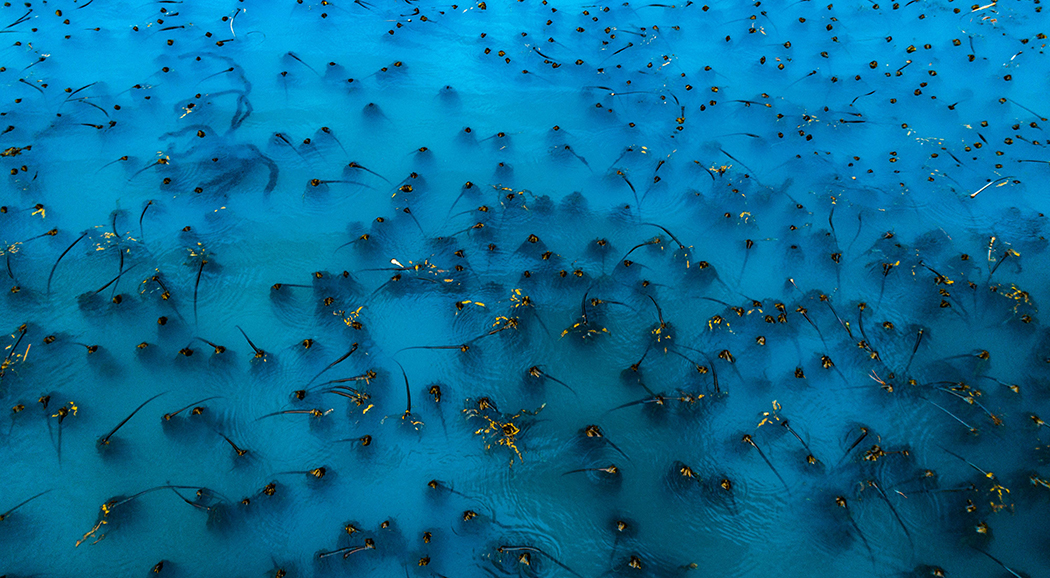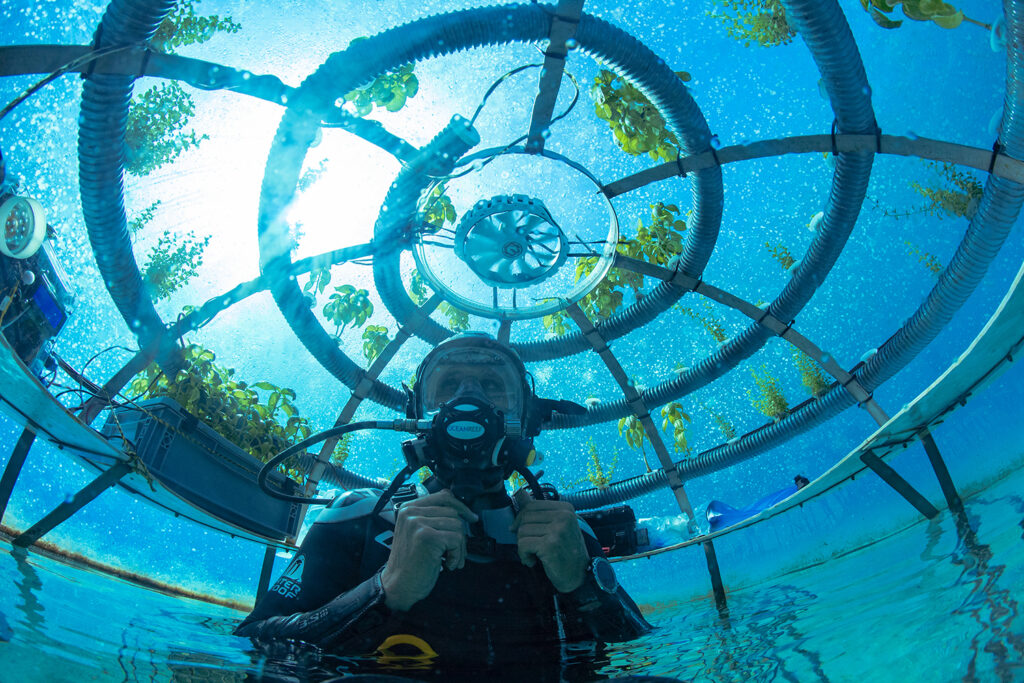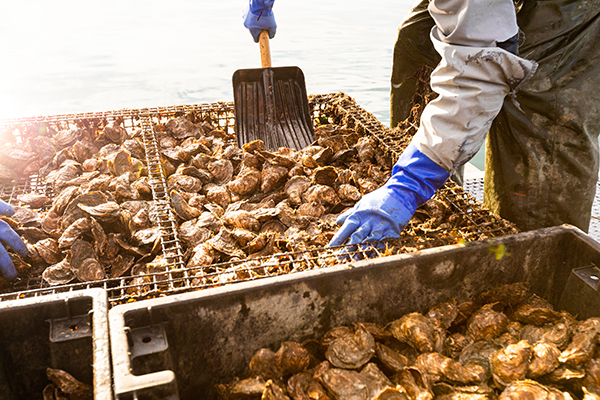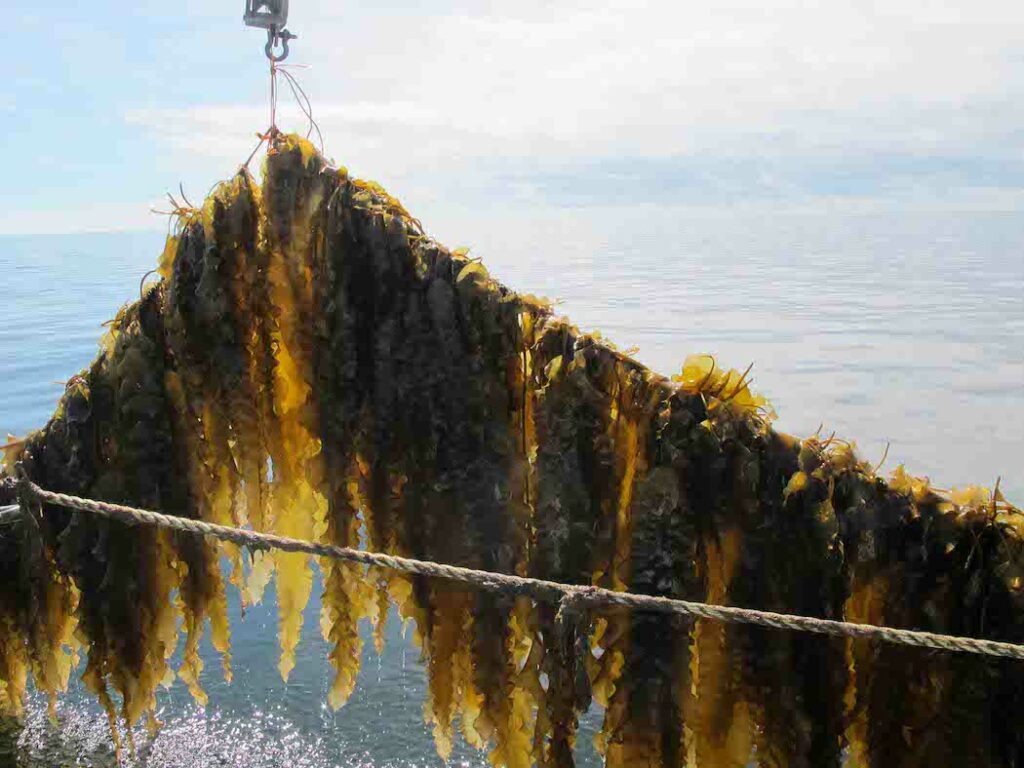Work inspired by ‘unprecedented and worsening’ collapse of kelp forests in California regions

This month, a group of U.S. scientists launched KelpWatch.org – the world’s largest digital map of kelp forests, both in terms of time and space. The open-source web tool analyzes nearly 40 years of Landsat satellite data and interactively displays the kelp forest canopy spanning from Baja California, Mexico to the Oregon-Washington State border.
“Kelp forests are home to thousands of species, locally mitigate the effects of ocean acidification and provide valuable services for coastal communities,” said Vienna Saccomanno, an ocean scientist with The Nature Conservancy who leads the group’s Kelp Mapping and Monitoring Program. “Knowing where remaining healthy kelp forests are located and the long-term history of kelp forests is the first step in strategic restoration. Kelpwatch.org provides this information and is a game-changer for resetting the ecosystem.”
The tool was developed jointly by The Nature Conservancy (TNC), Woods Hole Oceanographic Institution, University of California, Los Angeles (UCLA) and the University of California, Santa Barbara (UCSB). Users can select a region, time frame and seasons of interest to animate the changes in the kelp canopy over time and freely download data.
“Kelpwatch.org provides a unique platform to visualize kelp canopy extent and download the corresponding data all in one place,” said Dr. Kristen Elsmore, an environmental scientist at CDFW. “The interactive features are particularly useful for preliminary evaluation of kelp within a given management area and exploration of potential sites for kelp restoration pilot projects. As a tool accessible to both the public and to resource managers, Kelpwatch.org can provide a central platform for data transparency and communication.”
The tool has launched amid historic and sustained declines in many kelp forest ecosystems, which provide “crucial services” to both humans and nature. Changing ocean conditions, including marine heatwaves linked to climate change, have precipitated the loss of kelp in many regions around the world, with further declines anticipated in response to ocean warming.
Prior to Kelpwatch.org, the lack of historical data on trends and changes in kelp forest abundance across large areas was a key challenge for researchers, as well as state agencies tasked with management. The web tool and its data have already been utilized to inform the California Department of Fish and Wildlife’s (CDFW) Enhanced Status Report for giant and bull kelp, as well as the early planning stages of developing the Kelp Restoration and Management Plan. The tool has also been used to catalyze scientific research by leading experts investigating the health of kelp forests in a changing ocean.
“We have found Kelpwatch.org to be invaluable for documenting regional patterns of kelp dynamics, especially for assessing the consequences and patterns of recovery from sea urchin outbreaks that followed the 2013 seastar wasting disease and the 2014–2016 marine heatwave,” said Dr. Mark Carr, a professor of marine ecology at the University of California, Santa Cruz. “It has been both a valuable research tool and for conveying the patterns of kelp loss to others.”
The researchers pioneered the technique of mapping kelp forest density from Landsat satellite imagery. In 2019, they initiated a collaboration with The Nature Conservancy in California to create an online visualization tool to improve kelp forest mapping and monitoring.
“The Landsat satellite program has provided images of the earth’s surface for more than 40 years, and so it is ideal for documenting long-term changes in ecosystems such as giant kelp forests,” said Dr. Cavanaugh, an associate professor in geography at UCLA. “We’ve developed new methods to process this enormous dataset to turn the imagery into maps of kelp canopy, and Kelpwatch.org provides an ideal platform to access and analyze these maps.”
Using the tool to conduct flagship analyses on kelp dynamics along the west coast of the U.S. in response to the 2014–2016 record-breaking marine heatwave, the Kelpwatch.org team discovered an “unprecedented and worsening” collapse of kelp forests around the Monterey Peninsula, an iconic kelp-dominated stretch of California’s coast.
Calling the loss around Monterey and elsewhere “alarming,” there are efforts to restore kelp forests in hard-hit places, such as the North Coast. The team referenced the “rapid recovery” of kelp canopy cover in Bahía Tortugas, Baja California Sur which showed complete and sustained recovery from the marine heatwave since 2018.
Funded by a multi-year grant from NASA’s Ocean Biology and Biochemistry program, the team plans to expand the tool to new geographies around the world where kelp forests are found, including Washington State, British Columbia, Southeast Alaska, the Falkland Islands, Chile, Tasmania and Australia.
“The large spatial coverage of Kelpwatch.org paired with decades of historical data allow ecosystem managers and the public to examine how changes to kelp forests in their locations of interest compare to the past four decades,” said Dr. Tom Bell, a scientist at Woods Hole Oceanographic Institution. “Kelp forests are incredibly dynamic systems, so having access to historical data gives anyone the power to determine if recent changes lie outside the range of natural variability.”
Access the tool at Kelpwatch.org.
Follow the Advocate on Twitter @GSA_Advocate
Now that you've reached the end of the article ...
… please consider supporting GSA’s mission to advance responsible seafood practices through education, advocacy and third-party assurances. The Advocate aims to document the evolution of responsible seafood practices and share the expansive knowledge of our vast network of contributors.
By becoming a Global Seafood Alliance member, you’re ensuring that all of the pre-competitive work we do through member benefits, resources and events can continue. Individual membership costs just $50 a year.
Not a GSA member? Join us.
Author
-
Responsible Seafood Advocate
[103,114,111,46,100,111,111,102,97,101,115,108,97,98,111,108,103,64,114,111,116,105,100,101]
Tagged With
Related Posts

Responsibility
Could cultivating kelp forests in salmon pens help ‘future-proof’ the sector?
KelpRing has received funding to explore the possible benefits of installing kelp forests within salmon pens to benefit cleaner fish.

Innovation & Investment
20,000 lettuces under the sea: Could underwater agriculture be the future of farming?
Preliminary research suggests that emerging mariculture methods could provide alternatives to land-based agriculture and within recirculating systems.

Responsibility
The Nature Conservancy defines restorative aquaculture in new study
The Nature Conservancy's latest study sets out a standard definition of and global principles for restorative aquaculture.

Responsibility
Pilot project cultivating kelp on shellfish leases demonstrates ‘extraordinary’ first year growth
A pilot project led by the Aquaculture Association of Nova Scotia has shown first-year success for cultivating kelp on shellfish leases in Nova Scotia.



